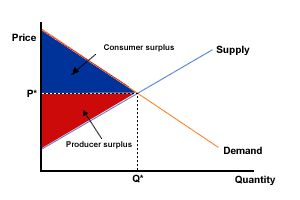Allocative efficiency
Syllabus: Evaluate the view that the best allocation of resources from society’s point of view is at competitive market equilibrium, where social (community) surplus (consumer surplus and producer surplus) is maximized (marginal benefit = marginal cost).Allocative efficiency is an important concept in economics and one we shall return to throughout this module. Allocative efficiency is essentially a situation where consumers are getting the maximum possible satisfaction from the current combination of goods and services being produced and sold. In other words by changing their pattern of consumption and buying different quantities of goods and services, consumers could not increase the satisfaction they are getting.
If we apply this concept at the level of a market, then we can see that society will get the maximum possible benefit when a market is in equilibrium. If we look at figure 1 below, then we can see that at a quantity of Q* (the equilibrium quantity), both consumer and producer surplus are maximised. If the economy was to produce a quantity below Q*, then more consumer and more producer surplus could be gained by a greater quantity being produced and sold of this good.

Figure 1 Consumer and producer surplus
Allocative efficiency requires two different types of efficiency:
- Efficiency in consumption - this is where consumers allocate their incomes in such a way that they get the maximum possible satisfaction from their limited incomes. We assume that this is what all rational consumers are trying to achieve.
- Efficiency in specialisation and exchange - this type of efficiency requires efficient markets where firms specialise in producing and selling and consumers specialise in working so that they can buy goods and services. In this way the markets are as efficient as is possible.
The combination of both these types of efficiency results in allocative efficiency. Allocative efficiency will be increased as long as doing more of something results in a greater marginal benefit to society than marginal cost. As long as this process continues, allocative efficiency will increase. The optimum level of allocative efficiency will be where this process reaches its logical conclusion. In other words where marginal benefit = marginal cost.
This is not specified on the syllabus but is an important concept and useful to know when investigating Market failureWhat is Pareto efficiency?
In order to explain what Pareto efficiency is, it might first be best to explain a Pareto improvement. A Pareto improvement occurs when there is a change in the allocation of resources which makes one person better off but doesn’t make anybody else worse off. For example if three people have 10 apples and one person gets one more apple it will be a Pareto improvement so long as the extra apple did not come at the expense of one of the other three individual’s apples. Pareto efficiency is said to exist when no other improvements can be made in the allocation of resources to one individual without it casing a loss to others. A simple way of explaining Pareto efficiency would be to say that a Pareto optimum refers to a situation where it is impossible to make one person better off without having to make other people worse off.
The reason why Pareto efficiency is not the same as equity (equity means fairness in this context)
The reason why Pareto efficiency is not related to equity is quite easy to understand. If one individual had a million apples and everybody else only had one apple then it would still be Pareto efficient so long as there is no way that one of the individuals could have two apples without taking the extra apple from someone else (including the one with a million apples). You can apply this to the taxation systems in most countries - the idea of taking from some to give to others.
How is Pareto efficiency used?
The idea of Pareto efficiency is often used in the real world. It provides justification for increasing the resources given to one group if doing so does not lower the resources of other groups. All though Pareto efficiency is not concerned with equity there are many who would see it as fair. When applying the concept to the real world there is often the idea of compensation; if a change causes a loss to one group but they receive compensation so that there is no real loss.
